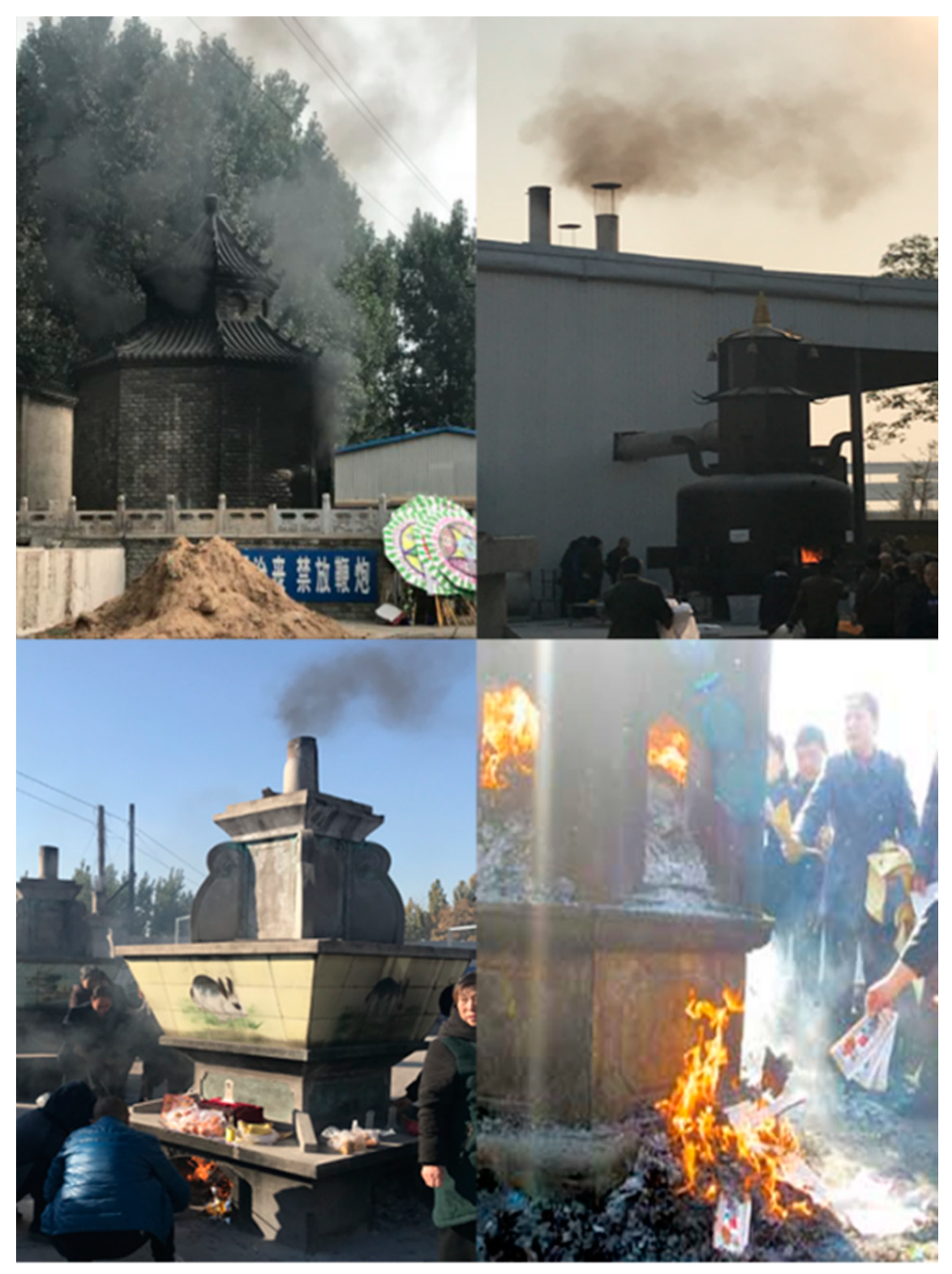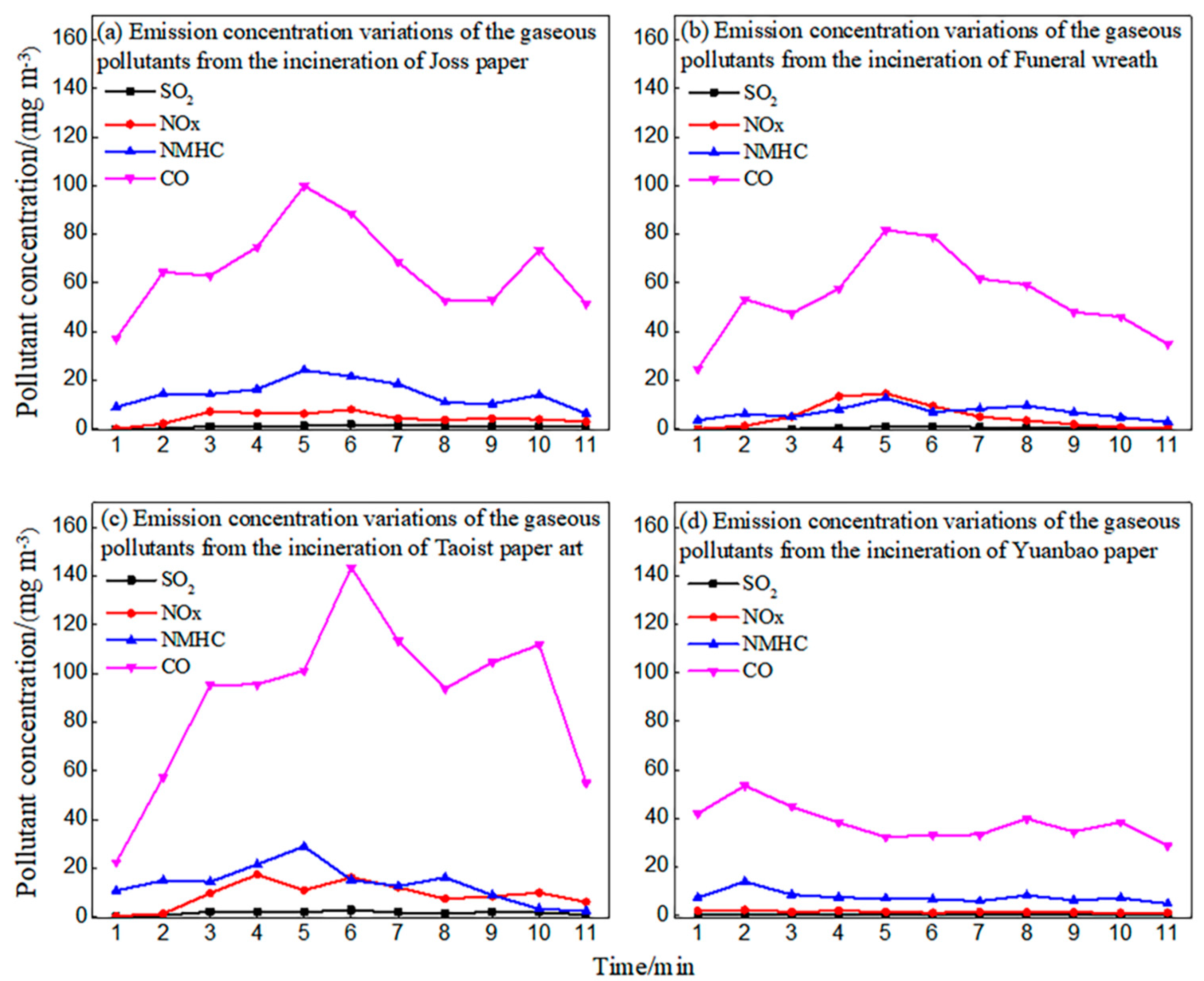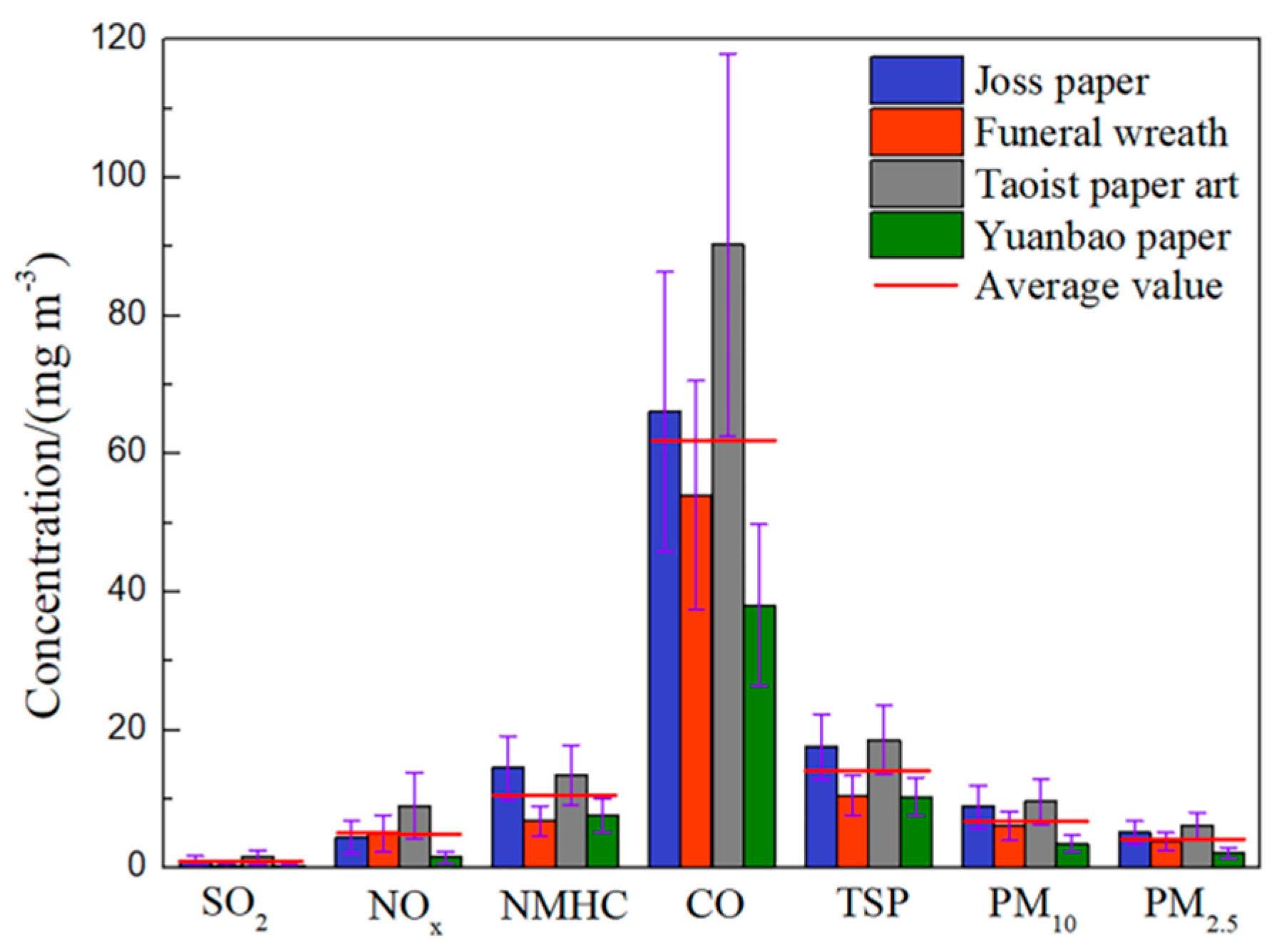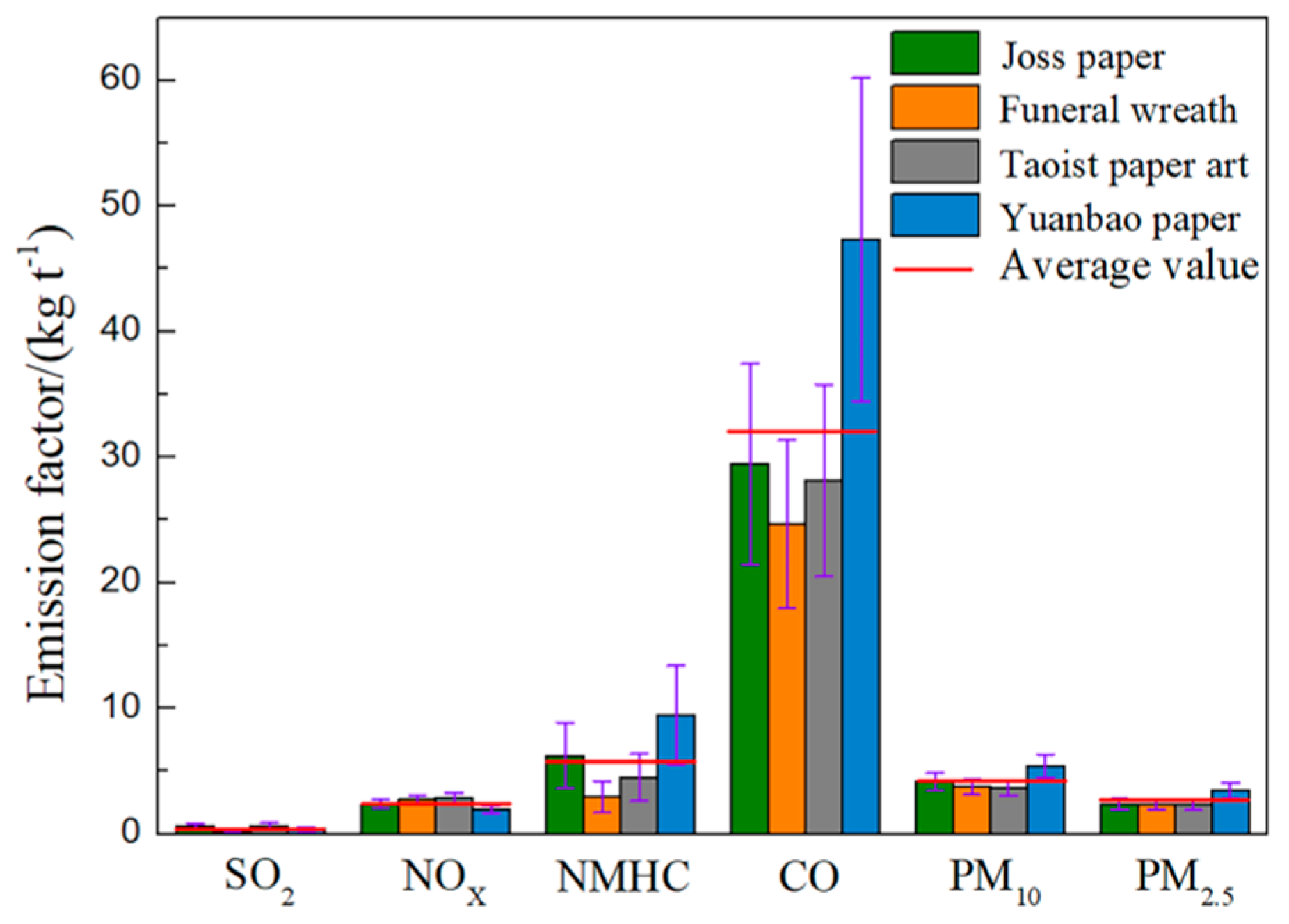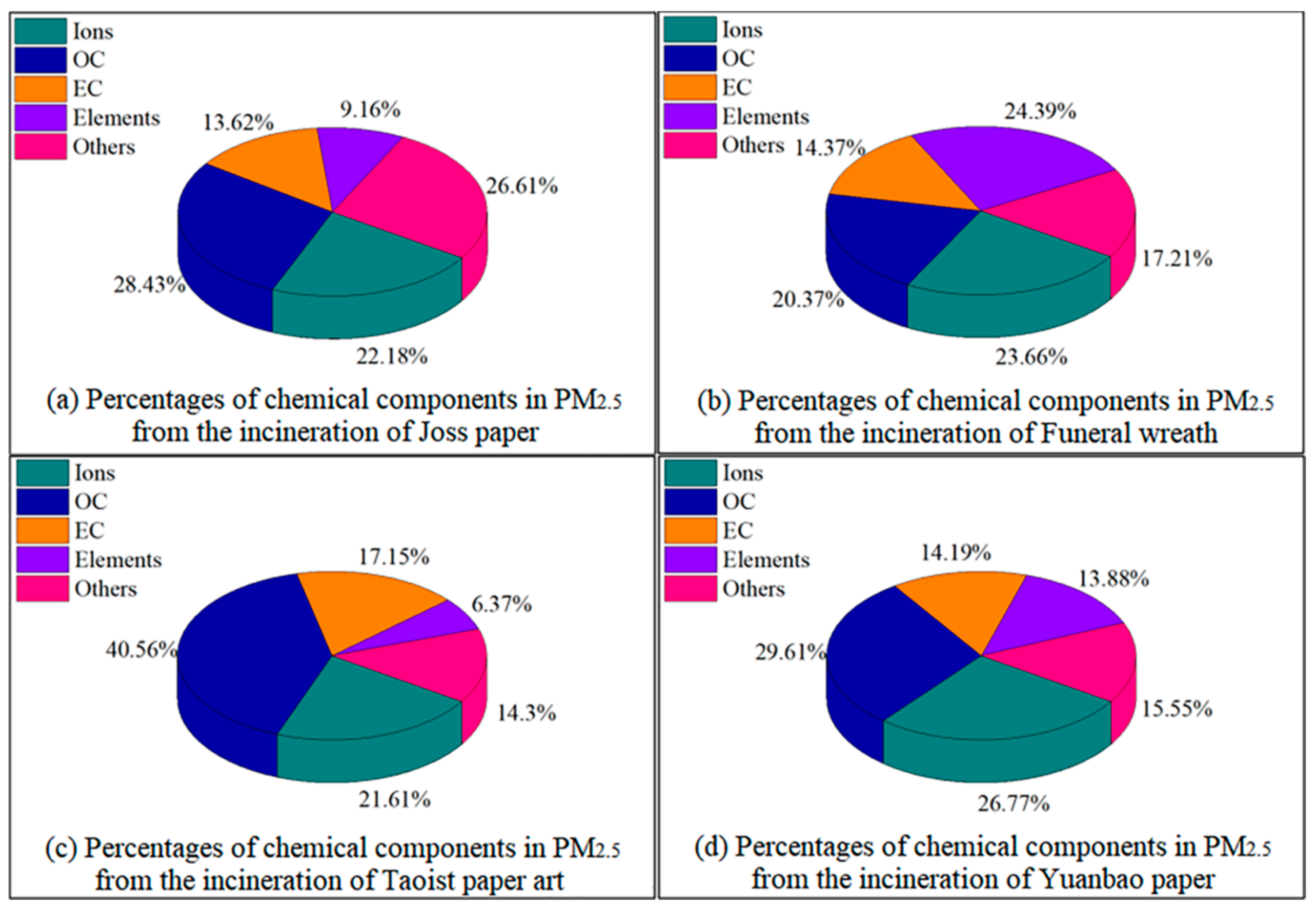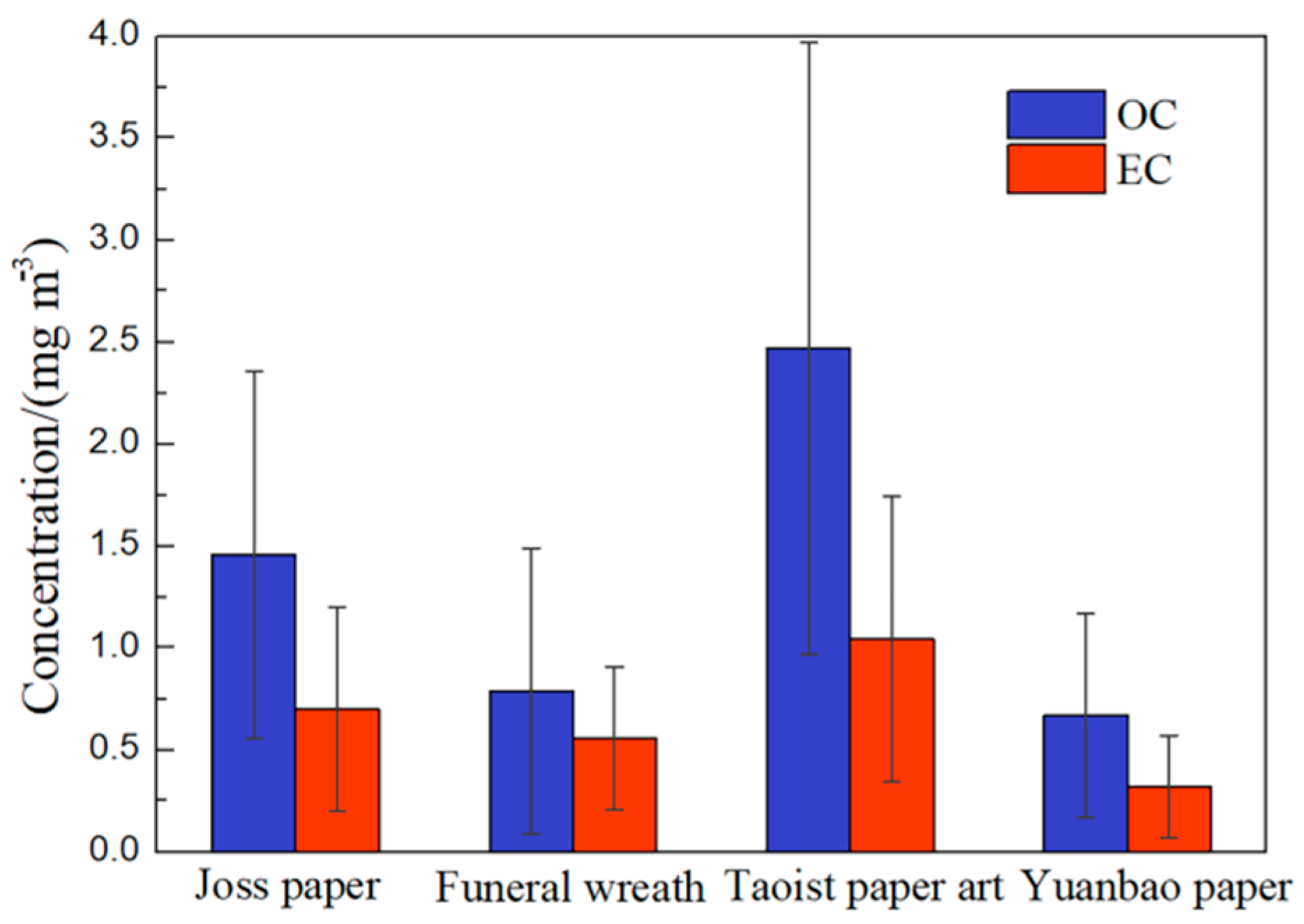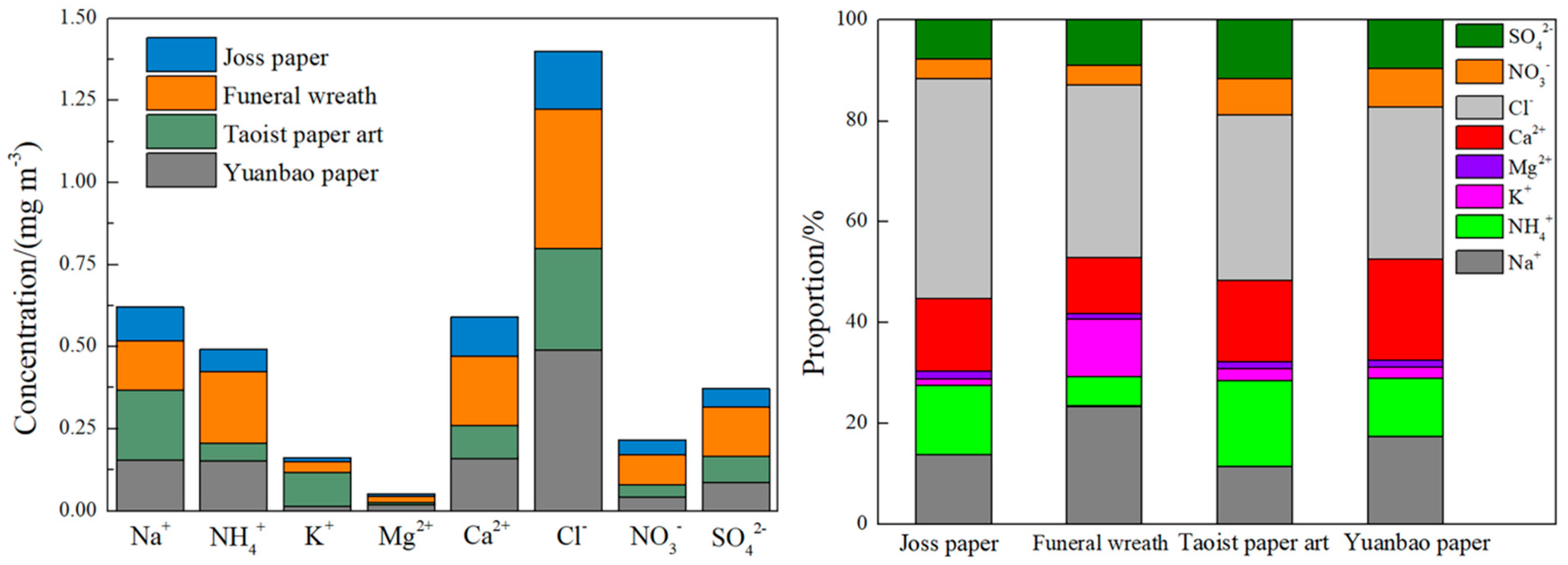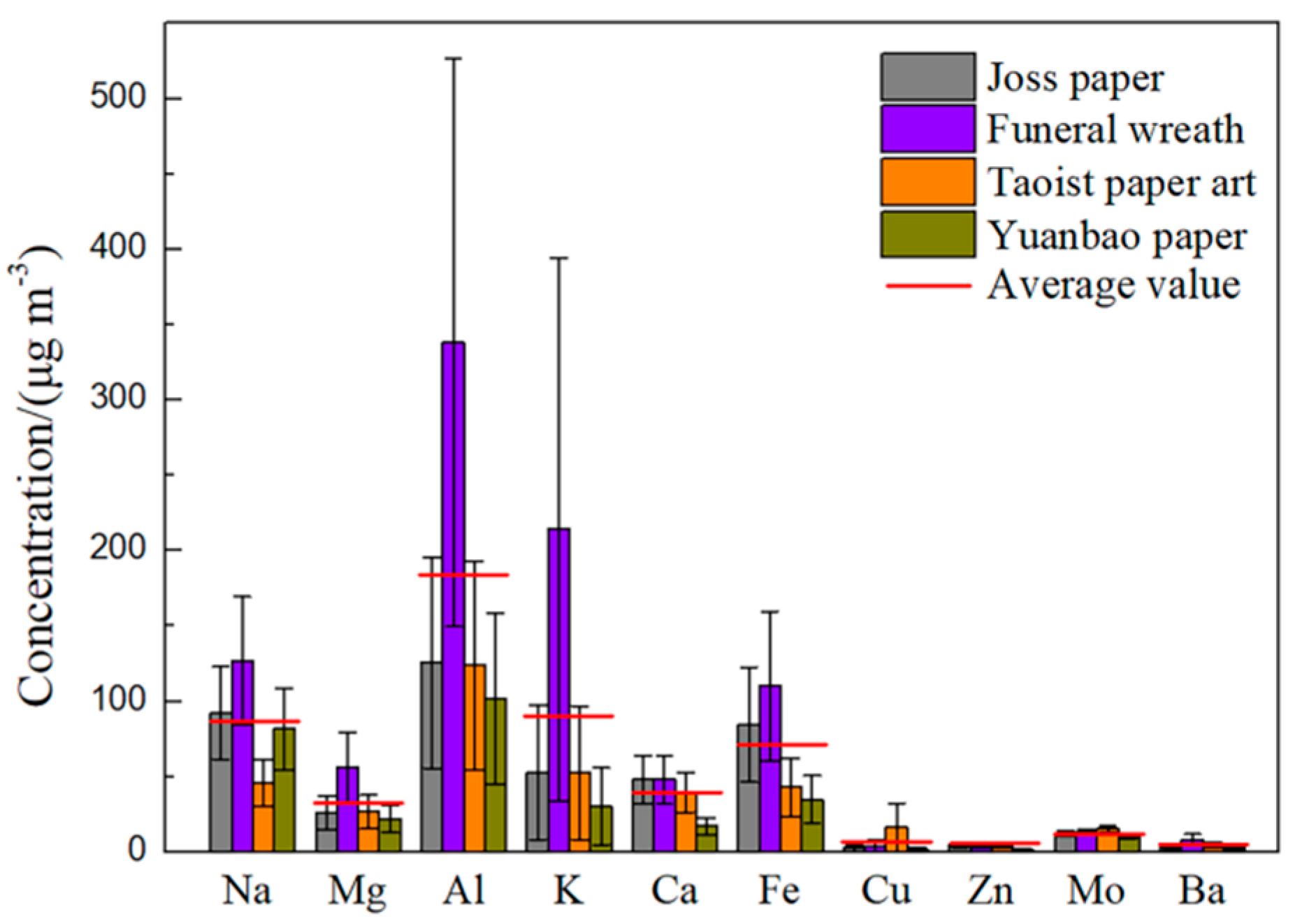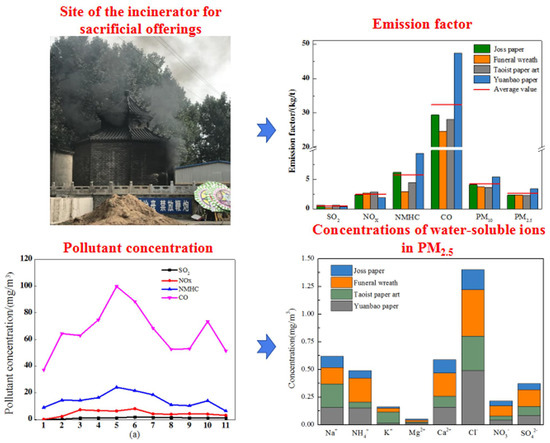1. Introduction
As a funeral custom, the incineration of sacrificial offerings is prevalent in China (
Figure 1). Because of the large number of deaths, the annual cremations and the quantity of the accompanying incineration of sacrificial offerings are very large. The incineration of sacrificial offerings (such as Joss paper, Funeral wreath, Taoist paper art, Yuanbao paper and cloths) generates large amounts of hazardous air pollutants, including PM, CO, SO
2, NO
x and NMHC [
1,
2,
3,
4,
5,
6]. The pollutants that are directly emitted to the atmospheric environment will participate in atmospheric photochemical reactions [
7,
8,
9,
10]. In addition, the large amounts of organic carbon, elemental carbon, inorganic ions and heavy metals in the particulate matter can directly or indirectly influence the solar radiation, thereby altering the radiation balance and photochemical properties of the atmosphere. These changes, in turn, lead to atmospheric haze, severely impacting the environment and human health [
11,
12,
13,
14]. Since the issuing of emission standards of air pollutants for crematories in 2015, certain crematories have set up special incinerators for sacrificial offerings. However, the unorganized, individual incineration of sacrificial offerings is still prevalent. Even in those crematories where special incinerators are set up for the incineration of sacrificial offerings, most have not installed flue gas purification systems. As a result, pollutants are directly discharged to the atmosphere without purification, causing severe impacts on the environment and human health in the surrounding areas. Although the visible emission and pollution are serious, due to custom, the pollution from the incineration of sacrificial offerings is usually ignored, and the quantification of the pollution emissions and emission factors and development of pollution control measures are lacking.
There have been few studies about the emission characteristics of the incineration of sacrificial offerings in China and abroad. Some researchers studied the emissions from the incineration of Joss paper in Taiwan. For example, Rau et al. [
15] sampled and analyzed the flue gas from the open burning of Joss paper. They found that the concentration of particulate matter can reach 76~732 μg m
−3, and the concentration of gaseous polycyclic aromatic hydrocarbons (PAHs) can reach as high as 1905.4 ng m
−3. Lin et al. [
16] determined that the total concentration of PAHs can reach 5384 ng m
−3 during the Hungry Ghost Festival in Taiwan, China. Chiu et al. [
17] analyzed the polychlorinated dibenzo-p-dioxins/dibenzofurans (PCDD/Fs) from the stack flue gases, fly ashes and bottom ashes. Past research mainly focused on the emissions and concentrations of particulate matters, PAHs and PCDD/Fs from incineration [
18,
19,
20]; however, investigations of the emission levels and characteristics of other hazardous pollutants (e.g., NMHC) are lacking. Therefore, these studies are insufficient to ascertain the characteristics of the air pollutants from the incineration of sacrificial offerings.
To find out the emission characteristics of the pollutants from the incineration of sacrificial offerings, establish a corresponding emission factor database and identify the chemical compositions of the pollution sources, we have chosen four typical sacrificial offerings in this study and carried out experiments for the emission of hazardous air pollutants. By using off-line and online analytical systems, we monitored the changes in the concentrations of gaseous pollutants and analyzed the chemical composition of particulate matter and their concentrations. Based on the experiments, we obtained emission factors for the hazardous air pollutants from the incineration of sacrificial offerings and identified the composition of the pollution sources. The results could provide a reference and support for the identification of pollution sources and pollution management and control.
2. Materials and Methods
2.1. Materials and Equipments
Based on the surveys we did in 19 crematoria, four common and typical sacrificial offerings were chosen for the incineration experiments, namely, Joss paper, Funeral wreath, Taoist paper art and Yuanbao paper (
Figure 2).
These four sacrificial offerings were individually placed in the incinerator for burning. Each sacrificial offering was divided into three parts by mass, and three repeated experiments were performed. Based on a large number of on-site investigations, the incinerator used in this research was the most mainstream incinerator of sacrificial offerings used in the crematorium. The flue gas was collected by the gas-collecting hood and was sucked into the tunnel through the wind-inducing effect from the high-capacity ventilator for sampling and monitoring. The experiment platform was shown in
Figure 3, including the incinerator, gas-collecting hood, dilution tunnel, particulate matter sampler, flue gas parameter tester, online monitoring instrument for atmospheric pollutants, filtration equipment and ventilator.
2.2. Sample Collection and Analysis
The equipment used for the collection and analysis of the hazardous air pollutants from the incineration of sacrificial offerings is listed in
Table 1. Before the start of the burning experiments, the quartz membranes (used for organic carbon (OC), element carbon (EC), ions and metal elements analysis) and Teflon membranes (used to calculate the weight of the particulate matters) were pretreated. The quartz membranes were burned at 600 °C for 4 h in a muffle furnace and then equilibrated for 24 h in a chamber at a constant temperature (25 °C) and constant humidity (0%rH). Finally, the membranes were weighed and stored in a membrane box. Similarly, the Teflon membranes were equilibrated for 24 h in a chamber at a constant temperature (25 °C) and constant humidity (0%rH) and weighed. Before starting the experiments, the sacrificial offerings used in the experiment were sorted and weighed, and the equipment was calibrated. In the monitoring and sampling stage, a Laoying3012H Automatic Stack Dust Sampler/Flue Gas Analyzer was first used to measure the velocity, temperature, humidity and pressure of the flue gas. Then, the measured parameters were input into the two-stage virtual impactor to set up the parameters of the sampler, and sampling heads were chosen for the capture of the particulate matter in the flue gas, with diameters in the ranges of 0~2.5 μm, 2.5~10 μm and 10~100 μm. A Thermo online monitoring system was used to record the changes in the gas concentrations every minute. After the experiment, the membranes were loaded into membrane box for cold storage. The concentrations of OC and EC, ions, and metal elements in the particulate matter were determined by using an OC/EC analyzer, ion chromatograph and Inductively coupled plasma mass spectrometry (ICP-MS), respectively. In order to compare with the national standard (GB 13801-2015) [
21] (
Table 2) in which the values are specified in the case of 11% oxygen content, the measured concentrations should be converted into 11% oxygen content.
2.3. Calculation of Emission Factors
Based on the data recorded on the gaseous pollutant online monitor, the experimental setup and the corresponding flue gas data, the equation for the calculation of the emission factors for the gaseous pollutants is shown below:
where EF
ij represents the emission factor of the type
j gaseous pollutant from the type
i sacrificial offering, with a unit of g kg
−1; C
ij represents the average monitoring concentration of the type
j gaseous pollutant from the type
i sacrificial offering, with a unit of mg m
−3;
r is the radius of the tunnel, with a unit of m;
v is the velocity of the flue gas in the tunnel, with a unit of m s
−1;
t is the sampling time, with a unit of s; and
mi represents the weight of the type
i sacrificial offering, with a unit of kg.
The calculation of the emission factors for the particulate matter is shown in the following equation:
where C
ip represents the concentration of particulate matter with a diameter of
p from the type
i sacrificial offering, with a unit of g m
−3; M is the mass increase of the membrane, with a unit of g;
Qp denotes the collection flow of particulate matter with a diameter of
p by the sampler, with a unit of L min
−1;
t is the sampling time, with a unit of min; EF
ip represents the emission factor of the particulate matter with a diameter of
p from the type
i sacrificial offering, with a unit of g kg
−1;
r is the radius of the tunnel, with a unit of m;
v is the velocity of the flue gas in the tunnel, with a unit of m s
−1; m
i represents the weight of the type
i sacrificial offering, with a unit of kg.
3. Results and Discussion
3.1. Emission Concentration Levels of Hazardous Air Pollutants
Figure 4 and
Figure 5 show the variations of emission concentration and the average concentrations of the gaseous pollutants from the incineration of Joss paper, Funeral wreath, Taoist paper art and Yuanbao paper. It can be seen from
Figure 4 that the changes of the pollutants (SO
2, NO
x, NMHC, CO) emitted from the incineration of the four sacrificial offerings were similar. In the initial stage, the pollutant concentration increased rapidly, but as the temperature gradually increased, the burning efficiency increased and the pollutant concentration decreased slightly. Among the gaseous pollutants, CO has the highest emission concentration, which can reach as high as 143.52 mg m
−3, indicating that the sacrificial offerings cannot be completely burned in the incineration process. This is followed by NMHC and NO
x. Because these offerings contain low contents of S, the concentrations of SO
2 generated from the burning are the lowest and show the smoothest changes.
It can be found from a comparison of the average concentrations of the atmospheric pollutants from the incineration of sacrificial offerings (
Figure 5) that the average concentration of CO is the highest, at 62.14 mg m
−3. If the measured concentration is converted into 11% oxygen content, it will be 621.4 mg m
−3, 3.1 times the national emission standard (GB 13801-2015) [
21]. The average concentrations of TSP, PM
10 and PM
2.5 are 14.29 mg m
−3, 7.06 mg m
−3 and 4.34 mg m
−3, respectively. If converted into 11% oxygen content, they will be 142.9 mg m
−3, 70.6 mg m
−3 and 43.4 mg m
−3, respectively. Among those, the TSP concentration is 1.8 times the national emission standard. The average concentrations of NO
x and SO
2 are 5.01 mg m
−3 and 0.85 mg m
−3, respectively. Next to CO, the emission concentration of NMHC is the highest, reaching 10.64 mg m
−3. These organic compounds may be the most important source of the "odor" in crematories [
22,
23,
24,
25]. However, in the relevant emission standards for pollutants from the incineration of sacrificial offerings, the emission concentration of NMHC is not regulated. Therefore, we recommend that emission standards should include indexes for these pollutants and urge the pollutant-producing parties to install activated carbon injection device to reduce the emissions.
3.2. Emission factors of Hazardous Air Pollutants
Based on the calculation methods in
Section 2.3, the overall average emission factors of the six pollutants of the incineration of the four typical sacrificial offerings (Joss paper, Funeral wreath, Taoist paper art and Yuanbao paper) are 7.53 kg t
−1, 6.10 kg t
−1, 7.01 kg t
−1 and 11.33 kg t
−1, respectively. Among those, the emission intensity of the atmospheric pollutants from the Yuanbao paper is the greatest, which is mainly due to its unique coating material. Furthermore, because of the coating, Yuanbao paper becomes much more non-flammable. The emission factors of SO
2, NO
x, NMHC, CO, PM
10 and PM
2.5 from the incineration of the four sacrificial offerings are shown in
Figure 6, and their average values are (0.47 ± 0.17) kg t
−1, (2.46 ± 0.35) kg t
−1, (5.78 ± 2.41) kg t
−1, (32.40 ± 8.80) kg t
−1, (4.23 ± 0.71) kg t
−1 and (2.62 ± 0.48) kg t
−1, respectively. Among them, the emission factor of CO is the greatest; this is mainly due to the insufficient burning of the sacrificial offerings, which results in a large emission of CO. Among the different sacrificial offerings, the emission factor of CO from Yuanbao paper is greater than that from Joss paper, Funeral wreath and Taoist paper art, 47.34 kg t
−1, indicating that the burning efficiency of the Yuanbao paper is lower than that of the other offerings. The emission factors of PM
10 and PM
2.5 from Yuanbao paper are also the greatest, 5.42 kg t
−1 and 3.44 kg t
−1, respectively.
In past studies, very little attention was paid to the emission of organic compounds in the incineration of sacrificial offerings. However, the measurement results show that the emission factor of NMHC is greater than that of SO2, NOx, PM10 or PM2.5. The emission factor of NMHC from Yuanbao paper is the greatest, 9.44 kg t−1. This finding is likely related to the unique coating material of Yuanbao paper. Therefore, to decrease the emission of NMHC from the incineration of sacrificial offerings, materials with low amount of organic matters should be chosen and the coating should be reduced. In addition, more attention should be paid to the emission of volatile organic compounds from the incineration of sacrificial offerings, which should be added to emission standards to provide guidance for the control of pollution sources.
3.3. Comparison to the Emissions of Other Burning Sources
The emissions of hazardous air pollutants from the incineration of sacrificial offerings are compared to that from similar burning sources such as cremators and the burning of straw, as shown in
Table 3. It can be seen that compared to the hazardous air pollutants not treated with a flue gas purification system from cremators (Cremator B), the emissions of the hazardous air pollutants from the incineration of sacrificial offerings are less intense. This finding is mainly because the cremation process requires fuel. In addition, the pollutants generated from the burning of the organic compounds in corpses result in a greater initial emission intensity. The emission intensity of pollutants from cremators after flue gas purification system (Cremator A) is greatly reduced and is significantly lower than the air pollutant emissions from the incineration of sacrificial offerings. The average emission factors of PM
10 and PM
2.5 generated from the incineration of sacrificial offerings are 24 and 48 times the emission intensity of pollutants from cremators treated with flue gas purification system. These results explain the significance of flue gas purification system in the control of pollutant emissions. Therefore, since the emission standards of air pollutants for crematories were issued and implemented in 2015, the control of pollution from cremators has been achieved. The installation rate of flue gas purification system for cremators increased gradually. However, the most incinerators of sacrificial offerings are not controlled. According to the statistical bulletin of Ministry of Civil Affairs, the amount of cremation reaches 4.82 million in 2017. The amount of incineration of sacrificial offerings in 2017 can reach about 144,600 tons. Thus, it is the relative contribution from the incineration of sacrificial offerings which will increase when more and more cremators have flue gas purification installed.
Compared to the open burning of straw, the emission levels of hazardous air pollutants are similar. The emission intensity of NO
x from the incineration of sacrificial offerings is slightly higher. However, the emission factors of particulate matters are relatively low. The emission factors of CO and particulate matters from incineration of wheat and cotton are much higher than sacrificial offerings. However, the burning of straw is mostly seasonal or short-term, whereas the incineration of sacrificial offerings is more common and regular, thus resulting in a greater atmospheric environmental hazard. Zhou et al. [
26] performed similar studies in Taiwan. They estimated the emission factors of SO
2, NO
x, CO and particulate matter from the burning of Joss paper by carrying out burning experiments and found that the emission factors of NO
x and CO are close to the emission factors of four types of sacrificial offerings in this study. However, the emission intensity of SO
2 was smaller in their study; this is related to the low S content in the materials of sacrificial offerings in Taiwan. The emission factor of PM
2.5 from the incineration of domestic waste paper falls within the range of this study. In this study, based on more types of sacrificial offerings, we obtained the emissions of several hazardous air pollutants including the emission characteristics of NMHC and particulate matter and their chemical compositions.
3.4. Chemical Compositions of Particulate Matter
As PM
2.5 is more likely to be breathed in, a chemical composition analysis of PM
2.5 was done in this research. The percentages of the chemical components in PM
2.5 generated from the burning of Joss paper, Funeral wreath, Taoist paper art and Yuanbao paper are shown in
Figure 7. The average percentages of ions, OC, EC and metal elements are (23.55 ± 10.37)%, (29.74 ± 9.95)%, (14.83 ± 6.55)% and (13.45 ± 4.88)%, respectively. Among those, the percentage of OC is the highest, thus indicating that the organic pollution is severe. This finding is particularly true for the incineration of Taoist paper art, which has a percentage of OC as high as 40.56%. This is related to presence of coating and a small amount of plastic protection film on the surface. The ion percentage is also high. The ion percentage from the incineration of Yuanbao paper is the highest, accounting for 26.77% of the chemical components in PM
2.5. The components that have the lowest percentage are the metal elements. Even so, the elemental content in Funeral wreath is as high as 24.39%. This is likely due to the use of metal wires in the production of the wreath. Therefore, materials used in the sacrificial offerings have a great influence on the composition of particulate matters.
3.4.1. OC and EC Components in Particulate Matter
The concentrations of EC and OC in PM
2.5 generated from the incineration of sacrificial offerings were monitored and analyzed using an OC/EC analyzer (as shown in
Figure 8). The average mass concentrations of OC and EC in PM
2.5 from four types of sacrificial offerings were 1.35 mg m
−3 and 0.65 mg m
−3, respectively, accounting for 31.0% and 15.1% of the PM
2.5, on average. The concentration of OC is much higher than that of EC, particularly in the incineration of Taoist paper art. The concentration of OC can be as high as 2.50 mg m
−3, 2.4 times that of EC, which is mainly because of the surface coating and plastic protection film. The results show that the organic pollution is severe in the incineration of sacrificial offerings. The average mass concentrations of OC and EC in the PM
2.5 of the surrounding atmosphere are 0.89~6.87 μg m
−3 (with an average of 3.88 μg m
−3) and 0.10~1.74 μg m
−3 (with an average of 0.92 μg m
−3), respectively, and the average concentrations in the flue gas from the incineration of sacrificial offerings are 348 and 707 times the above values. Thus, the direct emission of flue gas generated from the incineration of sacrificial offerings to the air will have a great impact on the surrounding air and environment.
The OC/EC ratio in PM
2.5 can be used to determine the presence of secondary pollution: if OC/EC > 2, secondary organic carbon is present; if OC/EC < 2, the secondary organic carbon can be ignored [
32]. Based on the measurement results, the OC/EC ratio in the PM
2.5 generated from the incineration of sacrificial offerings is 2.1, indicating that secondary organic carbon is present in the flue gas and can contribute to air pollution by secondarily formed aerosol. Based on the chemical characteristics of the PM
2.5 from the incineration of sacrificial offerings, it is necessary to reinforce the control and emission reduction measures for particulate matter generated from the incineration of sacrificial offerings and install high-efficiency dust removal equipment.
3.4.2. Water-Soluble Inorganic Ions in Particulate Matter
The water-soluble inorganic ions in the PM
2.5 generated from the incineration of sacrificial offerings were analyzed. The concentration of each type of inorganic ion and its percentage in the total concentration of inorganic ions are shown in
Figure 9. Cl
− has the highest concentration in the particulate matter, at 1.40 mg m
−3, followed by Na
+, which has a concentration of 0.62 mg m
−3. The high concentrations of Cl
− are mainly attributed to the plastic protection film on the surface. Cl
− accounts for 43.7%, 34.4%, 32.8%, and 30.1% of the total concentrations of water-soluble inorganic ions in Joss paper, Funeral wreath, Taoist paper art and Yuanbao paper, and Na
+ accounts for 13.9%, 23.5%, 11.6% and 17.5%, respectively. Among the eight water-soluble inorganic ions, Cl
−, Na
+, Ca
2+, NH
4+ and SO
42− are significantly higher than K
+, Mg
2+, NO
3−, and they account for 89.0% of the total inorganic ions.
3.4.3. Concentrations of Elements in Particulate Matter
The 27 elements detected in the PM
2.5 generated from the incineration of sacrificial offerings were analyzed. The 10 elements that have the highest concentrations are Na, Mg, Al, K, Ca, Fe, Cu, Zn, Mo and Ba. Their mass concentrations are shown in
Figure 10. Al, K, Na, Fe, Mg and Ca account for 92.8% of the total elements. Among those, the concentration of Al is the highest, accounting for 26.7%, 35.8%, 31.9% and 32.4%, respectively, of the elements in Joss paper, Funeral wreath, Taoist paper art and Yuanbao paper. This finding is related to the composition of the raw materials in the sacrificial offerings. The concentrations of certain metals in the particulate matter generated from the burning of Funeral wreath are much higher than those from Joss paper, Taoist paper art and Yuanbao paper. For example, the concentration of Al can be as high as 338.07 μg m
−3, 3.3 times that in Yuanbao paper, and the concentration of K is as high as 214.03 μg m
−3, 7.0 times that in Yuanbao paper. The high concentrations of certain metals in Funeral wreath is likely due to the use of metal wires. Al, K, Na, Fe, Mg and Ca are the six elements that contribute most to the incineration of sacrificial offerings, and the analysis provides a basis to the source apportionment.
4. Conclusions
In order to better understand emission characteristics of hazardous air pollutants from the incineration of sacrificial offerings, we conducted incineration experiments for typical sacrificial offerings and obtained the emission levels and emission factors of hazardous air pollutants, which can provided support for management of pollution prevention and control. The main conclusions are as follows:
(1) Flue gas generated from the incineration of sacrificial offerings has a considerable impact on the surrounding environment. The emission concentrations of CO and TSP seriously exceed the national emission standard. Furthermore, the emission of NMHC is the most important source of the odor in crematories, and if people are exposed to the environment for a long time, their health will be threatened. Emission standards should include indexes for these pollutants and urge the pollutant-producing parties to install activated carbon injection device to reduce the emissions.
(2) Among the four different sacrificial offerings, the average emission factor of Yuanbao paper is the greatest, which is mainly due to the unique coating material. Because of the coating, Yuanbao paper becomes much more non-flammable and the emission intensity of NMHC is largest. To decrease the emission of NMHC from the incineration of sacrificial offerings, materials with low amount of organic matters should be chosen and the coating should be reduced. As for different pollutants, the emission intensity of CO is the highest, which is mainly due to the insufficient burning. By comparison, it was found that the emission factors of sacrificial offerings are significantly higher than the emission factors of cremators equipped with the flue gas purification systems, and are equivalent to the open burning of straw. The environmental pollution from the incineration of sacrificial offerings cannot be ignored.
(3) In addition, the chemical composition of the PM2.5 generated from the incineration of sacrificial offerings was analyzed for the first time in this study. The average percentages of ions, OC, EC and metal elements are (23.55 ± 10.37) %, (29.74 ± 9.95) %, (14.83 ± 6.55) % and (13.45 ± 4.88) %, respectively. Materials used in the sacrificial offering have a great influence on the composition of particulate matters. The chemical composition analysis of the particulate matter provides guidance and support for source apportionment.
(4) It is a quite common phenomenon that the flue gas from incineration of sacrificial offerings is directly emitted into the atmosphere without purification. Based on the findings, crematoria should control the amount of incineration of sacrificial offerings. Types of sacrificial offerings with the characteristic of flammable and low amount of hazardous materials should be chosen. In order to reduce the emissions, the government should formulate corresponding documents to supervise the crematoria to install flue gas purification systems.
Author Contributions
Conceptualization, Y.X. and W.W.; methodology, S.Z., Y.L. and J.L.; formal analysis, S.Z., X.C. and X.Z.; investigation, S.Z., J.L. and K.X.; data curation, Y.X. and L.Z.; writing—original draft preparation, S.Z.; writing—review and editing, Y.X. and W.W.
Funding
This work was funded by the National Natural Science Foundation of China (21806012), the National Key Research and Development Program of China (2016YFC0201106), the Science Foundation of Beijing Municipal Research Institute of Environmental Protection (2017B01), and the Beijing Excellent Personnel Training Project (2017000021733G105).
Conflicts of Interest
The authors declare no conflict of interest.
References
- Khezri, B.; Chan, Y.Y.; Tiong, L.Y.; Webster, R. Annual air pollution caused by the Hungry Ghost Festival. Environ. Sci. Process. Impacts 2015, 17, 1578–1586. [Google Scholar] [CrossRef]
- Shen, H.Z.; Tsai, C.M.; Yuan, C.S.; Jen, Y.H.; Le, L.R. How incense and joss paper burning during the worship activities influences ambient mercury concentrations in indoor and outdoor environments of an Asian temple? Chemosphere 2017, 167, 530–540. [Google Scholar] [CrossRef]
- Hu, M.T.; Chen, S.J.; Lai, Y.C.; Huang, K.L.; Chang-Chien, G.P.; Tsai, J.H. Characteristics of polychlorinated dibenzo-p-dioxins/dibenzofuran from joss paper burned in Taiwanese temples. Aerosol Air Qual. Res. 2009, 9, 369–377. [Google Scholar] [CrossRef]
- Xue, Y.F.; Tian, H.Z.; Yan, J.; Xiong, C.C.; Pan, T.; Nei, L.; Wu, X.Q.; Li, J.; Wang, W.; Gao, J.J.; et al. Present and future emissions of HAPs from crematories in China. Atmos. Environ. 2016, 124, 28–36. [Google Scholar] [CrossRef]
- Xue, Y.F.; Yan, J.; Tian, H.Z.; Xiong, C.C.; Li, J.D.; Wu, X.Q.; Wang, W.; Zhu, J.X. Situation and Characteristics of Air Pollutants Emission from Crematories in Beijing, China. Environ. Sci. 2015, 36, 1959–1965. [Google Scholar]
- Yin, W.H.; Yu, X.W.; Han, J.L.; Feng, G.X.; Fu, J.P.; Yang, Y.Y.; Ju, Y.M.; Zhang, S.K. Emission of PCDD/Fs from crematories and its influencing factors. Environ. Sci. 2015, 36, 3596–3602. [Google Scholar]
- Hui, L.R.; Liu, X.G.; Tan, Q.W.; Feng, M.; An, J.L.; Qu, Y.; Zhang, Y.H.; Cheng, N.L. VOC characteristics, sources and contributions to SOA formation during haze events in Wuhan, Central China. Sci. Total Environ. 2019, 650, 2624–2639. [Google Scholar] [CrossRef]
- Liu, Y.L.; Li, Q.Q.; Su, G.J.; Wei, D.; Zheng, M.H.; Gao, L.R.; Liu, W.B.; Liu, G.R. Photochemical conversion of toluene in simulated atmospheric matrix and characterization of large molecular weight products by plus APPI FT-ICR MS. Sci. Total Environ. 2019, 649, 111–119. [Google Scholar] [CrossRef]
- Rissanen, M.P. NO2 suppression of autoxidation-inhibition of gas-phase highly oxidized dimer product formation. ACS Earth Space Chem. 2018, 2, 1211–1219. [Google Scholar] [CrossRef]
- Wu, Y.Z.; Ge, X.L.; Wang, J.F.; Shen, Y.F. Responses of secondary aerosols to relative humidity and photochemical activities in an industrialized environment during late winter. Atmos. Environ. 2018, 193, 66–78. [Google Scholar] [CrossRef]
- Goudarzi, G.; Shirmardi, M.; Naimabadi, A.; Ghadiri, A.; Sajedifar, J. Chemical and organic characteristics of PM2.5 particles and their in-vitro cytotoxic effects on lung cells: The Middle East dust storms in Ahvaz, Iran. Sci. Total Environ. 2019, 655, 434–445. [Google Scholar] [CrossRef]
- Liu, B.S.; Bi, X.H.; Feng, Y.C.; Dai, Q.L.; Xiao, Z.M.; Li, L.W.; Wu, Z.H.; Yuan, J.; Zhang, Y.F. Fine carbonaceous aerosol characteristics at a megacity during the Chinese Spring Festival as given by OC/EC online measurements. Atmos. Res. 2016, 181, 20–28. [Google Scholar] [CrossRef]
- Malaguti, A.; Mircea, M.; La Torretta, T.M.G.; Piersanti, A.; Salvi, S.; Zanini, G.; Telloli, C.; Salfi, F.; Berico, M. Fine carbonaceous aerosol characteristics at a coastal rural site in the Central Mediterranean as given by OCEC online measurements. J. Aerosol Sci. 2013, 56, 78–87. [Google Scholar] [CrossRef]
- Zhong, S.; Zhang, L.S.; Jiang, X.Y.; Gao, P. Comparison of chemical composition and airborne bacterial community structure in PM2.5 during haze and non-haze days in the winter in Guilin, China. Sci. Total Environ. 2019, 655, 202–210. [Google Scholar] [CrossRef]
- Rau, J.Y.; Tseng, H.H.; Lin, M.D.; Wey, M.Y.; Lin, Y.H.; Chu, C.W.; Lee, C.H. Characterization of polycyclic aromatic hydrocarbon emission from open burning of joss paper. Atmos. Environ. 2008, 42, 1692–1701. [Google Scholar] [CrossRef]
- Lin, M.D.; Rau, J.Y.; Tseng, H.H.; Wey, M.Y.; Chu, C.W.; Lin, Y.H.; Wei, M.C.; Lee, C.H. Characterizing PAH emission concentrations in ambient air during a large-scale joss paper open-burning event. J. Hazard. Mater. 2008, 156, 223–229. [Google Scholar] [CrossRef]
- Chiu, J.C.; Shen, Y.H.; Li, W.H.; Lin, L.F.; Wang, L.C.; Chang-Chien, G.P. Emissions of polychlorinated dibenzo-p-dioxins and dibenzofurans from an electric arc furnace, secondary aluminum smelter, crematory and joss paper incinerators. Aerosol Air Qual. Res. 2011, 11, 13–20. [Google Scholar] [CrossRef]
- Lin, T.C.; Chang, F.H.; Hsieh, J.H.; Chao, H.R.; Chao, M.R. Characteristics of polycyclic aromatic hydrocarbons and total suspended particulate in indoor and outdoor atmosphere of a Taiwanese temple. J. Hazard. Mater. 2002, 95, 1–12. [Google Scholar] [CrossRef]
- Lo, Y.Y.; Wang, I.C.; Lee, M.L.; Chou, M.S. Removal of Particulates from Emissions of Joss Paper Furnaces. Aerosol Air Qual. Res. 2011, 11, 429–436. [Google Scholar] [CrossRef]
- Yang, H.H.; Jung, R.C.; Wang, Y.F.; Hsieh, L.T. Polycyclic aromatic hydrocarbon emissions from joss paper furnaces. Atmos. Environ. 2005, 39, 3305–3312. [Google Scholar] [CrossRef]
- Ministry of Ecology and Environment of the People’s Republic of China (MEEPRC). GB 13801-2015 Emission Standard of Air Pollutants for Crematory; Ministry of Ecology and Environment of the People’s: Beijing, China, 2015.
- Matsunaga, S.N.; Chatani, S.; Morikawa, T.; Nakatsuka, S.; Suthawaree, J.; Tajima, Y.; Kato, S.; Kajii, Y.; Minoura, H. Evaluation of non-methane hydrocarbon (NMHC) emissions based on an ambient air measurement in Tokyo area, Japan. Atmos. Environ. 2010, 44, 4982–4993. [Google Scholar] [CrossRef]
- Hsueh, H.T.; Ko, T.H.; Wen, C.C.; Hung, W.C.; Chu, H. Health risk of aerosols and toxic metals from incense and joss paper burning. Environ. Chem. Lett. 2012, 10, 79–87. [Google Scholar] [CrossRef]
- Wang, M.; Shao, M.; Chen, W.T.; Lu, S.H.; Liu, Y.; Yuan, B.; Zhang, Q.; Zhang, Q.; Chang, C.C.; Wang, B.; et al. Trends of non-methane hydrocarbons (NMHC) emissions in Beijing during 2002–2013. Atmos. Chem. Phys. 2015, 14, 85–94. [Google Scholar] [CrossRef]
- Yang, B.B.; Zhang, L.J. Current Status and Existing Problems of Cremation Burning Pollution. Environ. Prot. Sci. 2007, 33, 11–12. [Google Scholar]
- Zhou, M.X. Reduction of Air Pollutants and Damage Assessment of Burning Joss Paper, Incense and Firecrackers: Composition Analysis and Emissions Estimation of Air Pollutants Produced by Burning Joss Paper and Incense; National Cheng Kung University: Tainan, Taiwan, 1996; pp. 1–44. [Google Scholar]
- Xue, Y.F.; Cheng, L.L.; Chen, X.; Zhai, X.M.; Wang, W.; Zhang, W.J.; Bai, Y.; Tian, H.Z.; Nie, L.; Zhang, S.H.; et al. Emission characteristics of harmful air pollutants from cremators in Beijing, China. PLoS ONE 2018, 13, e0194226. [Google Scholar] [CrossRef]
- Ministry of Ecology and Environment of the People’s Republic of China (MEEPRC). Technical Guidelines of Emission Inventory Preparation for Air Pollutants from Biomass Combustion (Trial)[EB/OL]; Ministry of Ecology and Environment of the People’s: Beijing, China, 2015.
- Qiu, X.; Duan, L.; Chai, F.; Wang, S.; Yu, Q.; Wang, S. Deriving high-resolution emission inventory of open biomass burning in china based on satellite observations. Environ. Sci. Technol. 2016, 50, 11779–11786. [Google Scholar] [CrossRef]
- Min, H.E.; Xing-Rui, W.; Li, H.; Xiao-Qiong, F.; Xue, M. Emission inventory of crop residues field burning and its temporal and spatial distribution in sichuan province. Environ. Sci. 2015, 36, 1208–1216. [Google Scholar]
- Wang, Y.; Hao, W.W.; Cheng, K.; Zhi, G.R.; Yi, P.; Fan, J.; Zhang, Y. Emission Characteristics and Chemical Components of PM2.5 from Open Burning of Municipal Solid Waste. Environ. Sci. 2018, 39, 3518–3523. [Google Scholar]
- Liu, H.L.; Peng, L.; Zhang, T.; Wang, Y.; Wang, Y.X. Distribution of carbon components and water-soluble inorganic ions in biomass burning dust. Chin. J. Environ. Eng. 2017, 11, 1672–1676. [Google Scholar]
© 2019 by the authors. Licensee MDPI, Basel, Switzerland. This article is an open access article distributed under the terms and conditions of the Creative Commons Attribution (CC BY) license (http://creativecommons.org/licenses/by/4.0/).
